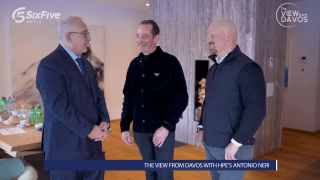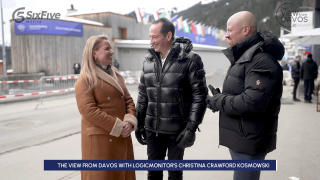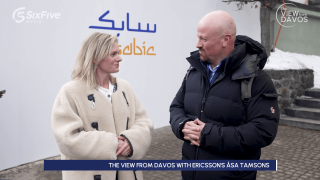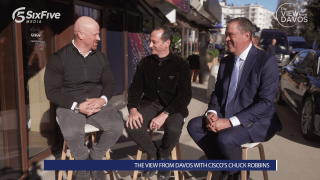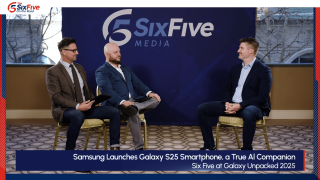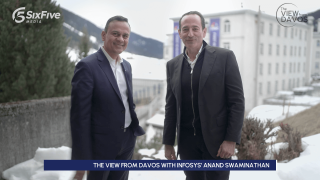On this episode of the Six Five On the Road, Keith Townsend and Dave Nicholson are joined by Ocient’s Shantan Kethireddy, Vice President of Customer Solutions for a conversation on the impact of AI on scalability, both technically and environmentally, and how Ocient’s high-density storage solutions are addressing these challenges.
Their discussion covers:
- An overview of Ocient and its role in enabling data-intensive analysis with an emphasis on performance, cost, and energy efficiency.
- The importance of high-density storage in delivering efficient data solutions and the partnership with Solidigm to achieve this.
- Insight into the types of customers and workloads Ocient supports, showcasing the versatility of their solutions across various sectors.
- How Ocient is addressing the technical and environmental scalability challenges posed by AI, focusing on optimizing hardware efficiency and minimizing energy consumption.
- Shantan’s anticipation for the future of hardware innovation revealed at Dell Tech World and its implications for Ocient’s service delivery.
Learn more at Ocient and Solidigm.com/AI.
Watch the video below, and be sure to subscribe to our YouTube channel, so you never miss an episode.
Or listen to the audio here:
Disclaimer: The Six Five Webcast is for information and entertainment purposes only. Over the course of this webcast, we may talk about companies that are publicly traded and we may even reference that fact and their equity share price, but please do not take anything that we say as a recommendation about what you should do with your investment dollars. We are not investment advisors and we ask that you do not treat us as such.
Transcript:
Keith Townsend: Welcome to Coverage of Solidigm and Solidigm Partners on The Six Five On the Road. I’m joined by my co-host, Dave Nicholson. Dave, it’s good to co-host something together.
Dave Nicholson: Finally.
Keith Townsend: Finally, we’ve known each other for years.
Dave Nicholson: Finally.
Keith Townsend: We’ve had these huge conversations on LinkedIn around-
Dave Nicholson: Mostly friendly.
Keith Townsend: Mostly friendly, but whenever you get into your cohort or the CTOs at Warden, those folks, I don’t know, they have ideas of their own. They think they can change the world, and they are. So it’s good to host with you, my friend.
Dave Nicholson: Likewise. Likewise.
Keith Townsend: Joining us, Shantan from Ocean. Shantan, welcome to the show.
Shantan Kethireddy: Thank you. I’m really happy to be here. And thanks to Six Five for hosting me. I’ve known you both for so many minutes.
Dave Nicholson: It feels like long ago, one big family. It’s the table. Welcome to Keith’s table.
Keith Townsend: We had to get on the road, both of us from Chicago, we had to get on the road to meet in person. So these things happen in the industry. So let’s start off the conversation by first, many people may not know, who is Ocient and what do you folks do?
Shantan Kethireddy: Sure. My favorite subject, so Ocient’s a data analytics and software solutions company. Workloads we focus on are really always on compute-intensive workloads. And so if I was to break that down, always on workloads for OLAP or real-time analytics is really about the data constantly coming and streaming in. Data is continuously coming in. Enterprises are storing it at very high resolution and retaining it for long periods of time. And so we really focus on compute-intensive workloads. And so if you were to break that down, that could be massive scale workloads.
So we have customers that are hundreds of terabytes to many petabytes, but that also can be CPU-intensive workloads. So lots of joins and multidimensional analysis. OCN sweet spot for these workloads is really achieving the best price performance and energy savings by partnering with our hardware partners like Solidigm. And so as far as what I do, I am the VP of Customer Solutions and services at Ocient. So while we bring to the table the combined hardware and software solution, you can imagine these are very complex solutions. Our process involves working with the customers to fully operationalize the solution from the first conversation all the way to production, so we can achieve ROIs with our customers in under a year.
Dave Nicholson: You’re both from Chicago. I’m from California. Partially, I admit what I just heard was kind of like a wah-wah-wah, power, power, power, power, power.
Shantan Kethireddy: Absolutely.
Dave Nicholson: Because where we can pay upwards of 60 cents a kilowatt-hour for a marginal kilowatt-hour of electricity, a lot of places in the country that doesn’t even mean anything to them. So all joking aside, seriously, what I just heard, intensive compute, compute, compute, it’s all about electricity going in. So what does that look like in terms of Solidigm as an example and what you do?
Shantan Kethireddy: Yeah, so if I was to talk about Solidigm, well, let me just talk about the explosion of data, if you will, and why the density of storage is really changing the game. So if you think about compute-intensive workloads, again, they could be massive scale. They can involve IO-intensive, CPU-intensive patterns. And so really in order to drive this really differentiated change, there’d be no Ocient without Solidigm. And what I mean by that is we try to drive this price performance and energy savings, but you really need an integration of the hardware stack, the software stack, as well as the solutions. So if I was to break that down, at the base, you have the NVME solid state drives, right, that Solidigm offers. And so the density of these drives, and also the IO throughput, the 4K read I/Os per second is massive in these drives. And they’re able to do things like we can write directly to the NVMe/SPDK, so we can squeeze all of the juice out of the NVMe drives as possible.
But I think fundamentally you can’t just throw software on top of NVMe solid state drives and get it to perform. So we’ve fully integrated with the NVMe drives, like Solidigm’s. Again, we push down IO as close to the system, as close to the drives as much as possible. We push the high core count CPUs directly next to the drives. Our goal is to eliminate IO as fast as possible and really work with the drives themselves. And to your point, when we talk about cost savings and energy savings, this is where it’s really compelling. The density of these drives, right? 16 terabyte SSD drives allows us to consolidate mixed workloads into the same system. So said another way, I can take an 60 to 80 node Elasticsearch or Hadoop cluster and bring it down to a 12 to 10 node Ocient cluster. And so now you really think about the very compelling kilowatt-hour savings that you’re alluding to.
Keith Townsend: So that’s one, it’s a lot of data. So it gives some context. Some of these Solidigm drives go up to 61 and a half terabytes of QLC space. That’s a lot of data. That’s a lot of IO going to the CPU. We would be remiss in the days of AI if we didn’t bring up AI in this data prep state. How much time, if any, are customers saving as a result of this compressed IO, this data pipeline that you folks have developed?
Shantan Kethireddy: Yeah, so talking about AI, everybody’s favorite subject, and I’m sure you both, every time you talk to somebody, they’re talking about their AI journey. And many enterprises are at the nascent stages. They’re all looking at different AI tools that are out there. But really, as we talk to enterprises, the biggest challenge they have is understanding the data itself. And so the struggles that they have are really thinking about the data lineage. What data do I have? How do I create my ontology or my semantic layer of that data? And so if you look at data science and machine learning modeling, what we commonly see is that the data scientists are given some sample of the data.
It could be some stale data, it may not even be relevant to what they’re looking at. And here you go, you go and play with this. Now compare and contrast that to a software stack like Ocient sitting on NVMe, where we’ve consolidated a lot of these solutions, the production data, along with the machine learning capabilities, the transformation capabilities into the same platform. Now assuming that you have the right security policies in place and the right workload management and service classes that we offer, the data scientists themselves can come directly to the data, and do machine learning model against the data.
They could do hypothesis analysis, they could do exploration of the data, they can transform the data and create derived sources and data sets so that they can play around with the data, and they can even integrate with their favorite tools, Jupyter Notebooks and Pandas and Gemini in Google. So these are the types of things that compare that to creating data copies and sprawl across the organizations, versus data scientists coming directly to the data. The last thing I’ll say is, with the hardware advances, we’re consistently looking at vector indexes and vector searches and being able to do different access methods to support large language models.
Dave Nicholson: Well, how much of Ocient’s business is dependent upon trends in AI moving forward, versus what we would think of as more traditional IT requirements? Because one of the things that gets lost in the discussion of AI is the fact that there’s a whole lot of IT going on that isn’t AI. And in fact, a lot of the AI that’s happening right now is really machine learning. Not that there’s anything wrong with that. I mean, it’s fantastic. But I guess my question is just from, if you’re an observer of Ocient and you’re saying, “Well, how well is Ocient going to do?” Are you wholly dependent upon this AI trend, or is it just like for others, a great thing to happen because it expands your business?
Shantan Kethireddy: Yeah, I love the question. So the adage, “We don’t go to where the puck is, we go to where the puck is going.” I think in any conversation that we have today, and I think as to what you’re alluding to, everybody says they’re on an AI journey, and it really is a journey. But a lot of what’s happening today is, I’m selecting AI tools. I’m doing some modeling, machine learning, which is a subset of the broad AI initiatives that our enterprises are going on. And so for us, we are supporting the typical OLAP style analytics, the real-time analytics, but we’re also supporting the AI journey. And what I mean by that is, today, the first stages are this exploration, hypothesis analysis, really understanding your data, doing data lineage, those types of exercises. All of those are supported within Ocient, but again, on the same system.
So going back to the energy story, not having the sprawl of disparate systems where I have my Mongo over here and I have my Databricks over here and I have my ETL solution over here, I could do all this work on the same system to support AI, and then to go to the next stage, which is really, how do I integrate with all of the different tools that enable AI directly from the data in the system? And so you do that by making sure that you support mixed workloads in the same system. So they can be their traditional OLAP, SQL-intensive analytics, but it can also be machine learning modeling. It can also be extracting the data to whatever solutions you have across your organization. The last thing I’ll say is that in any conversation that we have positioning our database, everything always comes down to a CFO discussion about cost, and how does this technology really support my broader initiatives? And of course, AI is the primary initiative that people talk about.
Keith Townsend: So talk to us about this conversation beyond the infrastructure, beyond Lego. We understand that what types of workloads will work well on Ocient, the capabilities from a technical perspective, speeds and feeds. Who is the Ocient customer? What solutions are you driving and value you’re driving for your customers?
Dave Nicholson: And I want to piggyback on that. Part of that is the question of your go-to-market strategy. So when you go out to have these conversations, what does that look like? Are you partnering with someone like a Solidigm to go in and have that overall conversation? What does that look like?
Shantan Kethireddy: Yeah, yeah, great question. So let me talk a little bit about the industries first. So where we find these complex workloads, I’m sure you guys could guess, but examples, government agencies that have large scale geospatial analytics, telecommunications companies. When you think about network analysis or you think about call detail record analysis, in ad tech, you had the demand side platforms and the supply side platforms and analyzing the data that’s created in the bidder exchanges. These are very voluminous and very complex.
But to the second part of your question, we see common themes across all of these workloads. And again, I keep harping on this, but it’s the theme of consolidation. So in these workloads, what patterns exist? First of all, everybody has a ETL platform that’s very cumbersome and they have JSON, Avro, CSV, Parquet, even mainframe data that’s feeding into these sources. And we integrated the transformation layer completely into our system, so there’s no separate interface. And then secondarily, to achieve the performance, again, with partners like Solidigm, we really focus on the solutions that help us drive the IO reductions, the data copy reductions. So we really think about 16 terabyte drives that we use from Solidigm.
We partner directly with them to say, “If we can get very dense drives in these systems, we could put a lot of workload into the same system, and we can sunset other systems that are out there.” And then the last piece is really the solutions model. You can imagine that again, with the complexity of data and the size of the data, you can’t just snap your fingers and operationalize a solution. So in terms of partnerships, absolutely, we partner with our hardware partners, with our software partners, with our cloud partners. But really the idea is, we don’t just push the onus on the customer to operationalize the solution. That could take years, right? We really bring to bear our expertise to help them from the first conversation, from the business case, financial case to the technical case, all the way to day one after purchase, they’re running in production. So it’s really a confluence of all these things.
Keith Townsend: So Shantan, last question, which is, what did we miss? But before that, Chicago guys, Cubs or Sox?
Shantan Kethireddy: That’s a great question.
Keith Townsend: Controversial. This is important because based on that answer, we may have a couple more questions.
Shantan Kethireddy: Well, I grew up a WGN guy watching Harry Caray every single day. Andre Dawson, Ryne Sandberg. So I’m a big Cubs fan.
Keith Townsend: The bane of my existence, WGN.
Shantan Kethireddy: Going the Cubs game tomorrow.
Keith Townsend: All right, what did we miss? Anything else you want our audience to know about Ocient?
Shantan Kethireddy: Yeah, I would just say it’s easy for somebody to come up here and say price performance and energy savings. A lot of vendors can claim that. And to Dave’s question, really, for us it’s about proof. And for Ocient, we approach engagements by saying, “Let us prove it to you.” As we talked about before, every discussion involves talking about what cost savings will you drive, how will you position yourselves with our broader innovation story?
And so for us, it’s imperative that we come with our partners to really prove out again, the business case, the financial case, the technical case. And so when we say there’s price performance and there’s energy savings, we want to show you how the combined hardware stack, the software stack and our solutions focus will lead to these ROIs and help with the overall AI journey that customers are on.
Keith Townsend: Shantan, thank you for stopping by The Six Five On The Road. If you want to follow more Six Five coverage, visit us on the web at sixfivemedia.com. Both me and Dave are going to continue this conversation on LinkedIn.
Dave Nicholson: Oh yeah.
Keith Townsend: There was a lot to digest from here.
Dave Nicholson: Yeah, there is.
Keith Townsend: And I’m sure that we’re going to have a robust conversation. Be sure to follow us in that conversation online. Until then, talk to you next Six Five On The Road.


